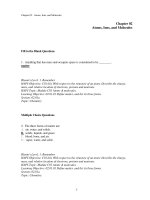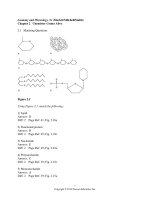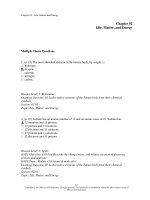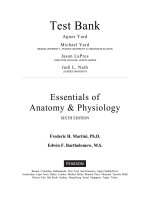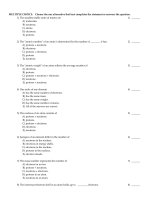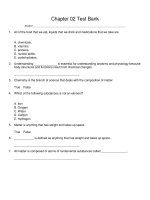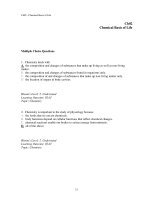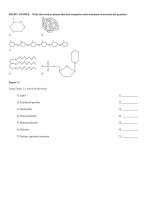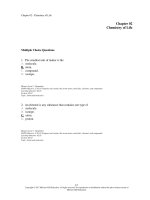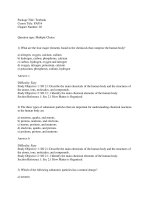Fundamentals of anatomy and physiology 9th edition martini test bank
Bạn đang xem bản rút gọn của tài liệu. Xem và tải ngay bản đầy đủ của tài liệu tại đây (313.38 KB, 22 trang )
MULTIPLE CHOICE. Choose the one alternative that best completes the statement or answers the question.
1) The smallest stable units of matter are
1) _______
A) molecules.
B) neutrons.
C) atoms.
D) electrons.
E) protons.
2) The "atomic number" of an atom is determined by the number of ________ it has.
A) protons + neutrons
B) electrons
C) protons + electrons
D) protons
E) neutrons
2) _______
3) The "atomic weight" of an atom reflects the average number of
A) electrons.
B) protons.
C) protons + neutrons + electrons.
D) neutrons.
E) protons + neutrons.
3) _______
4) One mole of any element
A) has the same number of electrons.
B) has the same mass.
C) has the same weight.
D) has the same number of atoms.
E) All of the answers are correct.
4) _______
5) The nucleus of an atom consists of
A) protons + neutrons.
B) protons.
C) protons + electrons.
D) electrons.
E) neutrons.
5) _______
6) Isotopes of an element differ in the number of
A) neutrons in the nucleus.
B) electrons in energy shells.
C) electrons in the nucleus.
D) protons in the nucleus.
E) electron clouds.
6) _______
7) The mass number represents the number of
A) electrons in an ion.
B) protons + neutrons.
C) neutrons + electrons.
D) protons in an atom.
E) neutrons in an atom.
7) _______
8) The innermost electron shell in an atom holds up to ________ electrons.
8) _______
A) 1
B) 2
C) 6
D) 8
E) 4
9) Radioisotopes have unstable
A) isotopes.
B) protons.
C) nuclei.
D) electron clouds.
E) ions.
9) _______
10) By weight, which element is the most plentiful in the human body?
A) sodium
B) sulfur
C) oxygen
D) potassium
E) carbon
10) ______
11) Indicate which of these lists contains only trace elements.
A) selenium, hydrogen, calcium
B) sulfur, chlorine, oxygen
C) cobalt, calcium, sodium
D) silicon, fluorine, tin
E) boron, oxygen, carbon
11) ______
12) The atomic number represents the number of
A) electrons in an atom.
B) neutrons in an atom.
C) protons in an atom.
D) chemical bonds the atom may form.
E) protons and neutrons in an atom.
12) ______
13) Helium (He) has an atomic number of 2. It is chemically stable because it
A) is neutral in electrical charge.
B) will form a covalent bond with another He atom.
C) readily ionizes to react with other atoms.
D) lacks electrons, thus the He atom is stable.
E) has a full outer electron shell.
13) ______
14) Which element commonly has only a proton as its nucleus?
A) argon
B) hydrogen
C) carbon
14) ______
D) helium
E) neon
15) By weight, which element is the second most abundant in the human body?
A) calcium
B) oxygen
C) hydrogen
D) nitrogen
E) carbon
15) ______
16) The mass of an atom is largely determined by the number of ________ it has.
A) protons
B) electrons
C) neutrons
D) protons + neutrons
16) ______
E) protons + electrons
17) If an isotope of oxygen has 8 protons, 10 neutrons, and 8 electrons, its mass number is
A) 12.
B) 16.
C) 18.
D) 8.
E) 26.
17) ______
18) If an element is composed of atoms with an atomic number of 6 and a mass number of 14, then a
neutral atom of this element contains
A) 6 protons.
B) 8 electrons.
C) 8 neutrons.
D) 6 protons and 8 electrons.
E) 6 protons and 8 neurons.
18) ______
19) The molecule NO is known as
A) nitrous oxide.
B) nitric oxide.
C) nitric oxygen.
D) noxious oxygen.
E) noxious oxide.
19) ______
20) The molecule CO2 is known as
20) ______
A)
B)
C)
D)
E)
carbon monoxide.
carbonated oxygen.
carbonized oxygen.
carbon dioxide.
carbon oxide.
21) The molecule H2 is known as
A)
B)
C)
D)
E)
21) ______
helium.
hydrohydrogen.
hydrogen.
hydroxide.
semi-water.
22) When electrons are transferred from one atom to another, and the two atoms unite as a result of
the opposite charges,
A) an ionic bond is formed.
B) a molecule is formed.
C) an ion is formed.
D) a hydrogen bond is formed.
E) a covalent bond is formed.
22) ______
23) Magnesium atoms have two electrons in the outermost shell. As a result, you would expect
magnesium to form ions with a charge of
A) +1.
B) -2.
C) +2.
D) -1.
E) either +2 or -2.
23) ______
24) Which of the following statements about hydrogen bonds is false?
A) Hydrogen bonds are responsible for many of the properties of water.
24) ______
B) Hydrogen bonds are strong attractive forces between hydrogen atoms and negatively
charged atoms.
C) Hydrogen bonds can form between neighboring molecules.
D) Hydrogen bonds can occur within a single molecule.
E) Hydrogen bonds are important for holding large molecules together.
25) The molecule O2 is known as
A) organic.
B) oxide.
25) ______
C) oxate
D) a salt
E) oxygen.
26) H2O is an example of a(n)
A) covalent formula.
B) ion.
C) glucose molecule.
D) compound.
E) ionic formula.
27) Which of the following is not a cation?
A) Ca2+
B) Na+
26) ______
27) ______
C) Cl-
D) K+
E) Mg2+
28) A dust particle floating on a water surface illustrates
A) hydrophilic attraction.
B) chemical tension.
C) surface tension.
D) heat capacity.
E) static electricity.
28) ______
29) In an aqueous solution, cations are attracted toward
A) salt.
B) hydrogen ions.
C) buffers.
D) anions.
E) sodium.
29) ______
30) In an aqueous solution, sodium ions would move toward
A) a negative terminal.
B) a positive terminal.
C) the bottom.
D) a pH terminal.
E) an organic terminal.
30) ______
31) The chemical behavior of an atom is determined by
A) the outermost electron shell.
B) the number of protons.
C) the mass of the nucleus.
D) the size of the atom.
E) the number of neutrons.
31) ______
32) Ions with a + charge are called
A) cations.
B) isotopes.
C) radicals.
D) positrons.
32) ______
E) anions.
33) The weakest bond between two atoms is the ________ bond.
A) ionic
B) hydrogen
C) covalent
D) polar
E) nonpolar
33) ______
34) When atoms complete their outer electron shell by sharing electrons, they form
A) hydrogen bonds.
B) cations.
C) anions.
D) covalent bonds.
E) ionic bonds.
34) ______
35) Ionic bonds are formed when
A) hydrogen forms bonds with negatively charged atoms.
B) an electron or electrons are completely transferred from one atom to another.
C) atoms share electrons.
D) two or more atoms lose electrons at the same time.
E) a pair of electrons is shared unequally by two atoms.
35) ______
36) If a pair of electrons is unequally shared between two atoms, a(n) ________ occurs.
A) double covalent bond
B) polar covalent bond
C) triple covalent bond
D) single covalent bond
E) hydrogen bond
36) ______
37) Elements that have atoms with full outer shells of electrons
A) will normally form cations.
B) frequently form hydrogen bonds.
C) will normally form anions.
D) are inert gases.
E) will form many compounds.
37) ______
38) Ions in an ionic molecule are held together due to
A) the presence of water molecules.
B) the sharing of electrons.
C) each electron orbiting all of the ions in the molecule.
D) the attraction of similar charges of the ions' protons.
E) the attraction of opposite electrical charges.
38) ______
39) An unequal sharing of electrons results in what type of chemical bonds?
A) hydrogen
B) ionic
C) covalent
D) polar covalent
E) peptide
39) ______
40) Sodium (Na) has an atomic number of 11. How many electrons are in the outer electron shell of
a
neutral
sodium
atom?
40)
___
___
A) 2
B) 8
C) 4
D) 1
E) 3
41) Oxygen (atomic number 8) requires how many additional electrons to fill its outer electron
shell?
A) 8
B) 1
C) 2
D) 6
E) 4
41) ______
42) The formula for methane gas is CH4. What does the formula 4CH4 represent?
42) ______
A)
B)
C)
D)
E)
4 molecules, each containing a carbon atom and 4 hydrogen atoms
a molecule with 4 carbon atoms and 16 hydrogen atoms
an inorganic compound with ionic bonds
a molecule with 4 carbon atoms
4 molecules, each containing a carbon and a hydrogen atom
43) In an ionic bond, the electron donor is the ________, whereas the electron acceptor is the
________.
A) salt, ion
B) cation, anion
C) anion, cation
D) base, acid
E) acid, base
43) ______
44) In a molecule of nitrogen, three pairs of electrons are shared by two nitrogen atoms. The type of
bond that is formed is an example of a(n)
A) double divalent bond.
B) triple covalent bond.
C) single trivalent bond.
D) hydrogen bond.
E) polar covalent bond.
44) ______
45) In chemical notation, the symbol Ca2+ means ________.
A) a calcium ion that has lost two electrons
B) a calcium ion that has lost two protons
C) a calcium ion that has gained two protons
D) two calcium atoms
E) a calcium ion that has gained two electrons
45) ______
46) Magnesium atoms have two electrons in the outermost shell and chlorine atoms have seven. The
compound magnesium chloride would contain
A) 1 magnesium and 1 chlorine.
B) 1 magnesium and 2 chlorine.
C) 2 magnesium and 7 chlorine.
D) 2 magnesium and 1 chlorine.
E) impossible to tell without more information
46) ______
47) AB → A + B is to decomposition as A + B → AB is to
A) combustion.
B) replacement.
C) synthesis.
D) metabolism.
E) exchange.
47) ______
48) The reaction N2 + 3 H2 → 2 NH3 is an example of a(n)
A)
B)
C)
D)
E)
48) ______
metabolic reaction.
decomposition reaction.
exchange reaction.
synthesis reaction.
enzyme reaction.
49) The reaction A + B + energy → AB is an example of a(n)
A) endergonic reaction.
B) exergonic reaction.
C) equilibrium reaction.
D) exchange reaction.
E) decomposition reaction.
49) ______
50) In hydrolysis reactions, compounds react with
A) glucose, causing decomposition.
B) hydrogen, causing decomposition.
C) water, causing decomposition.
D) water, causing synthesis.
E) carbon, causing decomposition.
50) ______
51) Which one of the following statements is not correct about the reaction H2 + Cl2 → 2 HCl?
51) ______
A) One molecule of hydrogen contains two atoms.
B) H2 and Cl2 are the reactants.
C) This reaction is easily reversible.
D) HCl is the product.
E) Two molecules of HCl are formed in the reaction.
52) In dehydration synthesis reactions, compounds
A) gain water molecules.
B) convert water molecules to hydrogen and oxygen.
C) gain electrons.
D) lose water molecules.
E) convert hydrogen and oxygen to water.
52) ______
53) In the reaction listed below, what coefficient needs to be added to balance the equation?
6 CO2 + 6 H2O → C6H12O6 + ________ O2
53) ______
A) 4
B) 6
C) 8
D) 2
E) 10
54) Chemical reactions that yield energy, such as heat, are said to be
A) exergonic.
B) thermonuclear.
C) neutral.
D) activated.
E) endergonic.
54) ______
55) All of the following are true concerning enzymes, except that they
A) function as biological catalysts.
B) lower the activation energy required for a reaction.
C) are consumed during the reaction.
D) affect only the rate of a chemical reaction.
55) ______
E) are proteins.
56) Compounds that can be synthesized or broken down by chemical reactions inside the body are
called
A) enzymes.
B) inorganic compounds.
C) nutrients.
D) metabolites.
E) organic compounds.
56) ______
57) Each of the following is an example of an inorganic compound, except
A) carbohydrates.
B) bases.
C) salts.
D) acids.
E) water.
57) ______
58) Identify which of the following is both an anion and a compound:
A) Na+
B) HCO3C) ClD) NaCl
58) ______
E) K+
59) Nonpolar organic molecules are good examples of
A) solutes.
B) electrolytes.
C) molecules that will dissociate when placed into water.
D) hydrophobic compounds.
E) hydrophilic compounds.
59) ______
60) During ionization, water molecules disrupt the ionic bonds of a salt to produce a mixture of ions.
These ions can carry a current and so are called
A) electrolytes.
B) acids.
C) anions.
D) counterions.
E) cations.
60) ______
61) Oppositely charged ions in solution are prevented from combining by
A) water's nonpolar nature.
B) hydration spheres.
C) hydrogen bonding.
D) free radicals.
E) heat capacity of water.
61) ______
62) An example of an inorganic substance is
A) water and carbon dioxide.
B) water.
C) carbon dioxide.
D) fructose.
E) glycerol.
62) ______
63) Hydrophilic molecules readily associate with
A) hydrophobic molecules.
B) water molecules.
63) ______
C) acids.
D) lipid molecules.
E) salts.
64) Which of the following statements about water is not correct?
A) It is composed of polar molecules.
B) It has a relatively low heat capacity.
C) It is responsible for much of the mass of the human body.
D) It contains hydrogen bonds.
E) It can dissolve many substances.
64) ______
65) Which property of water helps keeps body temperature stabilized?
A) thermal inertia
B) kinetic energy
C) surface tension
D) reactivity
E) lubrication
65) ______
66) Of the list below, which has the highest concentration of hydroxide ions?
A) pH 1
B) pH 14
C) pH 7
D) pH 2
E) pH 10
66) ______
67) Which pH is closest to normal body pH?
A) pH 8
B) pH 4
E) pH 7
67) ______
C) pH 3
D) pH 2
68) A(n) ________ removes hydrogen ions and a(n) ________ releases hydrogen ions.
A) element; compound
B) molecule; acid
C) base; acid
D) compound; element
E) acid; base
68) ______
69) An excess of hydrogen ions in the body fluids can have fatal results because this can
A) change the shape of large complex molecules, rendering them nonfunctional.
B) change body fluid pH.
C) disrupt tissue functions.
D) break chemical bonds.
E) All of the answers are correct.
69) ______
70) A solution containing equal numbers of hydrogen ions and hydroxide ions is
A) basic.
B) in equilibrium.
C) acidic.
D) alkaline.
E) neutral.
70) ______
71) The chemical notation that indicates concentration is represented as
A) ||.
B) ().
C) <>.
D) [ ].
E) {}.
72) If a substance has a pH that is greater than 7, it is
A) acidic.
B) alkaline.
C) neutral.
E) a buffer.
73) Which pH of the following is the most acidic?
71) ______
72) ______
D) a salt.
73) ______
A) pH 3
B) pH 2
C) pH 1
D) pH 6
E) pH 4
74) Which pH of the following is the least acidic?
A) pH 6
B) pH 4
C) pH 2
D) pH 3
E) pH 1
74) ______
75) An important buffer in body fluids is
A) H2O.
75) ______
B) NaOH.
C) NaCl.
D) NaHCO3.
E) HCl.
76) Which of the following substances would be most acidic?
A) stomach secretions, pH = 1
B) urine, pH = 6
C) lemon juice, pH = 2
D) tomato juice, pH = 4
E) white wine, pH = 3
76) ______
77) Of the following choices, the pH of the least acidic solution is
A) 1.0.
B) 4.5.
C) 6.0.
D) 2.3.
77) ______
E) 12.0.
78) Which has the greater concentration of hydrogen ions, a substance with a pH of 5 or a substance
with a pH of 4?
A) A pH of 4 is greater.
B) A pH of 5 is greater.
C) They are both equal; 4 and 5 are relative values.
D) pH 9, if you mixed the solutions.
E) There is not enough information to determine.
78) ______
79) In the body, inorganic compounds
A) are structural components of cells.
B) can make up proteins.
C) can serve as buffers.
D) are metabolized for cellular energy.
E) are made from organic compounds.
79) ______
80) When placed in water, an inorganic compound dissociates 99 percent, forming hydrogen ions
and anions. This compound would be
A) a strong base.
B) a weak base.
C) a weak acid.
D) a salt.
E) a strong acid.
80) ______
81) When a small amount of HCl or NaOH is added to a solution of Na 2HPO4, the pH of the
81) ______
solution barely changes. Based on these observations, all of the following are true concerning the
compound Na2HPO4, except
A) Na2HPO4 adsorbs excess H+ and OH- directly onto the surface of its crystalline structure.
B) Na2HPO4 acts as a buffer.
C) Na2HPO4 is able to accept extra hydrogen ions from the HCl.
D) Na2HPO4 is able to donate hydrogen ions to the OH- from NaOH.
E) Na2HPO4 is a salt formed from reacting a strong base with a weak acid.
82) Carbohydrates, lipids, and proteins are classified as
A) salts.
B) inorganic molecules.
C) organic molecules.
D) acids.
E) bases.
82) ______
83) A functional group is best described as reoccurring clusters of
A) atoms that greatly influence the chemical properties of molecules they are part of.
B) elements that form at high pH.
C) atoms that function in the body.
D) amino acids in a globular protein.
E) elements that occur in a salt.
83) ______
84) Artificial sweeteners
A) are usually not broken down by the body.
B) are always some form of carbohydrate.
C) provide the same number of calories as an equivalent amount of sucrose.
D) are naturally similar to sugars.
E) are inorganic sugar substitutes.
84) ______
85) Fructose is
A) a carbohydrate.
B) a hexose.
C) found in male reproductive fluids.
D) an isomer of glucose.
E) All of the answers are correct.
85) ______
86) Molecules that have the same molecular formula but different structural formulas are called
A) isotopes.
B) isozymes.
C) isomoles.
D) isotypes.
E) isomers.
86) ______
87) The most important metabolic fuel molecule in the body is
A) protein.
B) sucrose.
C) glucose.
87) ______
D) caffeine.
E) vitamins.
88) A polysaccharide that is formed in liver and muscle cells to store glucose is
A) lactose.
B) sucrose.
C) fructose.
D) cellulose.
E) glycogen.
88) ______
89) The group of organic compounds containing carbon, hydrogen, and oxygen in a near 1:2:1 ratio
is defined as a
A) carbohydrate.
B) lipid.
89) ______
C) protein.
D) saturated fat.
E) nucleic acid.
90) An example of an organic substance is:
A) sodium chloride
B) nitric oxide
C) carbonic acid
D) sucrose
E) oxygen
90) ______
91) Carbohydrate molecules
A) form the regulatory molecules known as enzymes.
B) are composed of C, H, O, and N atoms.
C) contain the genetic information found in cells.
D) are the body's most readily available source of energy.
E) are the building blocks of cellular membranes.
91) ______
92) When two monosaccharides undergo a dehydration synthesis,
A) two new monosaccharides are formed.
B) a disaccharide is formed.
C) hydrolysis occurs.
D) a polysaccharide is formed.
E) a starch is formed.
92) ______
93) To bond two monomers together, a molecule of water must be ________ to/from from
monomers. This process is called ________.
A) added; hydrolysis
B) removed; crenation
C) added; denaturation
D) removed; dehydration synthesis
E) added; ionization
93) ______
94) Lipids
A) form essential structural components of cells.
B) cushion organs against shocks.
C) help to maintain body temperature.
D) provide a significant energy reserve.
E) All of the answers are correct.
94) ______
95) A fatty acid that contains two or more double covalent bonds is said to be
A) polyunsaturated.
B) hydrogenated.
C) saturated.
D) monounsaturated.
E) carboxylated.
95) ______
96) Alaska Natives have a lower incidence of heart disease even though their diets are high in fat
and cholesterol. This may be due to the large amount of ________ in their diets.
A) vitamins
B) prostaglandins
C) omega-3 fatty acids
96) ______
D) triglycerides
E) oleic acid
97) Which of the following is/are needed to form a triglyceride molecule?
A) 3 glycerol molecules
B) 3 glycerol molecules and 3 fatty acid molecules
C) 3 fatty acid molecules and 1 glycerol molecule
D) 1 glycerol molecule
E) 3 fatty acid molecules
97) ______
98) A shortage of steroids in the body would result in a shortage of
A) proteins.
B) glycogen.
C) sex hormones and plasma membranes.
D) sex hormones.
E) plasma membranes.
98) ______
99) Most of the fat found in the human body is in the form of
A) cholesterol.
B) prostaglandins.
C) monoglycerides.
D) triglycerides.
E) phospholipids.
99) ______
100) Lipids that are produced by nearly every tissue in the body and act as local regulators are the
A) phospholipids.
B) glycolipids.
C) steroids.
D) monoglycerides.
E) prostaglandins.
100) _____
101) Cholesterol, phospholipids, and glycolipids are examples of
A) structural lipids.
B) lipid drugs.
C) dietary fats.
D) prostaglandins.
E) steroids.
101) _____
102) A fatty acid with no double bonds between carbon atoms is
A) polyunsaturated.
B) saturated.
C) denatured.
D) dehydrated.
E) unsaturated.
102) _____
103) Lipids are composed of fatty acids and
A) polypeptides.
B) glycerol.
C) amino acids.
D) monosaccharides.
E) sugars.
103) _____
104) The monomers of protein are
A) fatty acids.
B) nitrogen base.
C) glucose.
D) nucleotides.
E) amino acids.
105) Substrate molecules bind to enzymes at the ________ sites.
A) carboxyl
B) amino
C) neutral
104) _____
105) _____
D) reactant
E) active
106) You would expect a peptide bond to link
A) two simple sugars.
B) two nucleotides.
C) a sugar and a peptide.
D) two amino acids.
E) a peptide and a fatty acid.
106) _____
107) Each amino acid differs from another in the
A) size of the amino group.
B) number of carboxyl groups.
C) number of peptide bonds in the molecule.
D) nature of the side chain.
E) number of central carbon atoms.
107) _____
108) The term ________ means each enzyme catalyzes only one type of reaction.
A) saturation
B) monoreactive
C) inertia
D) activation
E) specificity
108) _____
109) A side chain on an amino acid is sometimes called ________.
A) a polypeptide chain
B) fibrous or globular
C) nucleic acid
D) an R group
E) an isozyme
109) _____
110) The alpha-helix and pleated sheet are examples of ________ protein structure.
A) tertiary
B) quaternary
C) pentanary
D) secondary
E) primary
110) _____
111) Interaction between individual polypeptide chains to form a protein complex is ________
structure.
A) quaternary
B) tertiary
C) pentagonal
D) secondary
E) primary
111) _____
112) Glycoproteins and proteoglycans are combinations of amino acids and
A) lipids.
B) inorganic compounds.
C) carbohydrates.
D) fatty acids.
E) nucleic acids.
112) _____
113) Which of the following is the symbol for an amino group?
A) -COOH
B) -OH
C) -AMO
113) _____
D) -NH2
E) -PO3
114) The maximum rate of an enzyme reaction occurs at
A) synthesis.
B) saturation limit.
C) hydrolysis.
D) reversible.
E) dehydration.
114) _____
115) How would the lack of a cofactor for an enzyme affect that enzyme's function?
A) The enzyme would not be able to function.
B) The enzyme would function more quickly.
C) The enzyme's function would not be altered.
D) The enzyme would function more slowly.
E) The enzyme would cease to function after reaching a maximum rate.
115) _____
116) An example of an organic substance is:
A) lipid and protein
B) nucleic acid
C) lipid, nucleic acid, and protein
D) lipid
E) protein
116) _____
117) Molecules that store and process genetic information are the
A) lipids.
B) steroids.
C) nucleic acids.
D) carbohydrates.
E) proteins.
117) _____
118) An amino acid is to a protein as ________ is to a nucleic acid.
A) a purine
B) a nucleotide
C) a proton
D) a neutron
E) a protein
118) _____
119) A nucleotide consists of
A) a five-carbon sugar and a nitrogenous base.
B) a phosphate group and a nitrogenous base.
C) a five-carbon sugar, a nitrogenous base, and a phosphate group.
D) a five-carbon sugar and an amino acid.
E) a five-carbon sugar and phosphate group.
119) _____
120) According to the rules of complementary base pairing in nucleic acids, cytosine would pair with
the base
A) uracil.
B) thymine.
C) adenine.
D) cytosine.
E) guanine.
120) _____
121) Adenine and guanine are
A) nucleotides represented by A and G.
B) purines represented by T and C.
C) purines represented by A and G.
D) pyrimidines represented by A and G.
E) pyrimidines represented by T and C.
121) _____
122) The structure of RNA differs from DNA in that
A) DNA contains pyrimidines but not purines.
B) RNA contains pyrimidines but not purines.
C) RNA contains purines but not pyrimidines.
D) the backbone of RNA contains ribose.
E) DNA contains purines but not pyrimidines.
122) _____
123) The most abundant high-energy compound in cells is
A) DNA.
B) adenosine triphosphate.
C) adenosine monophosphate.
D) RNA.
E) adenosine diphosphate.
123) _____
124) A high-energy bond in ATP is present
A) between the first and second phosphate group.
B) between the second and third phosphate group.
C) between adenine and a phosphate group.
D) between adenine and ribose.
E) between phosphate groups 1 and 2 and between phosphate groups 2 and 3.
124) _____
125) The phosphorylation of adenosine forms
A) 2ATP.
B) ribose.
C) ATP.
125) _____
D) ADP.
E) AMP.
126) Identify the product formed from the phosphorylation of ADP.
A) adenosine diphosphate
B) deoxyribonucleic acid
C) adenine
D) adenosine triphosphate
E) ribose
126) _____
127) AMP + P →
A) ADP
127) _____
B) DNA
C) 2ADP
D) ATP
E) adenine
128) The average time between synthesis and breakdown is known as the ________ time.
A) anabolism
B) metabolism
C) turnover
D) specificity
E) catabolism
128) _____
129) Muscle proteins are destroyed after 17 days and then replaced. This is an example of
A) disease.
B) surveillance.
C) specificity.
D) metabolic turnover.
E) surface tension.
129) _____
130) Continuous breakdown and replacement of cellular molecules is termed
A) metabolic turnover.
B) metabolism.
C) organic chemistry
D) anabolic turnover.
E) catabolic turnover.
130) _____
SHORT ANSWER. Write the word or phrase that best completes each statement or answers the question.
131) A(n) ________ is a pure substance composed of atoms of only one kind.
131) ____________
132) The center of an atom is called the ________.
132) ____________
133) Electrons whirl around the center of the atom at high speed, forming a(n) ________.
133) ____________
134) Electrons in an atom occupy an orderly series of electron shells or ________.
134) ____________
135) The actual mass of an atom is known as its ________ ________.
135) ____________
136) Atoms of the same element whose nuclei contain the same number of protons, but
different numbers of neutrons, are called ________.
136) ____________
137) The ________ of a radioactive substance is the time required for 50 percent of a given
amount of radioisotope to decay.
137) ____________
138) Ions with a positive charge are called ________.
138) ____________
139) Ions with a negative charge are called ________.
139) ____________
140) Kinetic energy is stored as ________ energy when a spring is stretched.
140) ____________
141) Chemical reactions that release energy are called ________.
141) ____________
142) Chemical reactions that absorb energy are called ________.
142) ____________
143) The three familiar states of matter are solids, liquids, and ________.
143) ____________
144) Chemical reactions that occur in the body are accelerated by ________.
144) ____________
145) In living cells, complex metabolic reactions proceed in a series of steps called a(n)
________.
145) ____________
146) Compounds that contain carbon as the primary structural atom are called ________
molecules.
146) ____________
147) Compounds that do not usually contain carbon as the primary structural atom are called
________ molecules.
147) ____________
148) A(n) ________ is a homogeneous mixture containing a solvent and a solute.
148) ____________
149) Soluble inorganic compounds whose solutions will conduct an electric current are called
________.
149) ____________
150) Molecules that do not readily interact with water are called ________.
150) ____________
151) The ________ of a solution is the negative logarithm of the hydrogen ion concentration
expressed in moles per liter.
151) ____________
152) All fatty acids contain a functional group at one end called the ________.
152) ____________
153) In water, phospholipids tend to form tiny droplets with hydrophobic tails buried inside
called ________.
153) ____________
154) Molecules with two fatty acid chains and a phosphate group that form biological
membranes are called ________.
154) ____________
155) Individual steroids differ in the ________ attached to the carbon rings.
155) ____________
156) The molecule DNA contains a five-carbon sugar called ________.
156) ____________
157) The purines found in DNA are ________ and guanine.
157) ____________
158) The pyrimidine bases found in DNA are ________ and cytosine.
158) ____________
159) The three structural components of a nucleotide are a pentose, a phosphate group, and a
_______ base.
159) ____________
160) A(n) ________ is a covalent bond that stores an unusually large amount of energy.
160) ____________
161) In the process of ________ a phosphate group is transferred to a molecule.
161) ____________
162) The hydrolysis of ATP yields ADP, phosphate ion, and ________.
162) ____________
ESSAY. Write your answer in the space provided or on a separate sheet of paper.
163) The element sulfur has an atomic number of 16 and mass number of 32. How many neutrons are in the
nucleus of a sulfur atom? If sulfur forms covalent bonds with hydrogen, how many hydrogen atoms can
bond to one sulfur atom?
164) What role do buffer systems play in the human body?
165) Blood has a very narrow normal pH range but urine has a very broad normal pH range. What does that
indicate about the physiology of pH?
166) Explain the role of water molecules in polysaccharide formation.
167) How does the DNA molecule control the appearance and function of a cell?
1)
2)
3)
4)
5)
6)
7)
8)
9)
10)
11)
12)
13)
14)
15)
16)
17)
18)
19)
20)
21)
22)
23)
24)
25)
26)
27)
28)
29)
30)
31)
32)
33)
34)
35)
36)
37)
38)
39)
40)
41)
42)
43)
44)
45)
46)
47)
48)
49)
50)
51)
C
D
C
D
A
A
B
B
C
C
D
C
E
B
E
D
C
E
B
D
C
A
C
B
E
D
C
C
D
A
A
A
B
D
B
B
D
E
D
D
C
A
B
B
A
B
C
D
A
C
C
52)
53)
54)
55)
56)
57)
58)
59)
60)
61)
62)
63)
64)
65)
66)
67)
68)
69)
70)
71)
72)
73)
74)
75)
76)
77)
78)
79)
80)
81)
82)
83)
84)
85)
86)
87)
88)
89)
90)
91)
92)
93)
94)
95)
96)
97)
98)
99)
100)
101)
102)
103)
D
B
A
C
D
A
B
D
A
B
A
B
B
A
B
E
C
E
E
D
B
C
E
D
A
E
A
C
E
A
C
A
A
E
E
C
E
A
D
D
B
D
E
A
C
C
C
D
E
A
B
B
104)
105)
106)
107)
108)
109)
110)
111)
112)
113)
114)
115)
116)
117)
118)
119)
120)
121)
122)
123)
124)
125)
126)
127)
128)
129)
130)
131)
132)
133)
134)
135)
136)
137)
138)
139)
140)
141)
142)
143)
144)
145)
146)
147)
148)
149)
150)
151)
152)
153)
154)
155)
E
E
D
D
E
D
D
A
C
D
B
A
C
C
B
C
E
C
D
B
E
E
D
A
C
D
A
element
nucleus
electron cloud
energy levels
atomic weight
isotopes
half-life
cations
anions
potential
exergonic
endergonic
gases
enzymes
pathway
organic
inorganic
solution
electrolytes
hydrophobic
pH
carboxylic acid group
micelles
phospholipids
side chains
156)
157)
158)
159)
160)
161)
162)
163)
deoxyribose
adenine
thymine
nitrogenous
high-energy bond
phosphorylation
energy
The number of neutrons in an atom is equal to the mass number minus the atomic number. Thus, sulfur has 32 - 16
= 16 neutrons. The atomic number indicates the number of protons, so a neutral sulfur atom contains 16 protons
plus 16 electrons to balance the protons electrically. The electrons would be distributed as follows: 2 in the first
electron shell, 8 in the second, and the remaining 6 in the third. To achieve a full 8 electrons in the third (outermost)
electron shell, the sulfur atom can accept 2 electrons in an ionic bond or can share 2 electrons in a covalent bond.
Because hydrogen atoms can share one electron in a covalent bond, the sulfur atom can form two covalent bonds
with hydrogen, one with each of two hydrogen atoms. In chemical notation, this is H 2S.
164) Buffer systems help maintain pH within normal limits by removing or replacing hydrogen ions as needed.
165) Homeostasis requires that the pH of body fluids be maintained almost constant to avoid disruptions of healthy
function. To accomplish this, the urinary system eliminates or retains hydrogen ion as needed. These actions cause
the pH of urine to vary widely, depending on whether there is too much or not enough hydrogen ion in the body.
166) Water molecules are removed in the dehydration synthesis of polysaccharides.
167) The DNA molecule controls the synthesis of enzymes and structural proteins. By controlling the synthesis of
structural proteins, the DNA is able to influence the physical appearance of a cell. By controlling the production of
enzymes, the DNA is able to control all aspects of cellular metabolism and thus control the activity and biological
functions of the cell.
